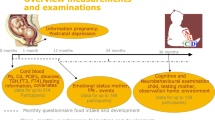Objective. To evaluate cognitive status in subjects exposed to ionizing radiation during antenatal development. Materials and methods. A total of 77 subjects with antenatal exposure to radiation were studied, along with a reference group of 73 subjects living in radiologically unpolluted territories in the Chelyabinsk region. Clinical, clinical psychological (Mini Mental State Examination, MMSE), Wechsler Adult Intelligence Test (WAIS), and proverb interpretation) neurophysiological (EEG), and laboratory (cholesterol, high- and low-density lipoproteins triglycerides, cortisol, melatonin) methods were used. Results and discussion. These investigations showed that a significantly greater proportion of subjects exposed to radiation during antenatal development had nonpsychotic mental disorders with a predominance of organic mental impairments (cognitive and asthenic). Neurophysiological studies identified more profound abnormalities in brain bioelectrical activity with pathological rhythms and a predominance of the θ rhythm among those exposed to radiation. Clinical psychological study data identified a significant decrease in analytical-synthetic ability in irradiated subjects, along with lower general and verbal IQ levels. These changes were accompanied by higher cortisol and melatonin levels, supporting activation of and tension in the mechanisms of adaptation in subjects irradiated during antenatal development.
Similar content being viewed by others
References
A. V. Akleev and M. F. Kiselev, Ecological and Medical Consequences of the 1957 Radiation Accident at the PO Mayak, Moscow (2001).
A. V. Akleev and M. F. Kiselev, Medical-Biological and Ecological Consequences of the Pollution of the River Techa, Moscow (2001).
A. V. Akleev, M. M. Kosenko, L. Yu. Krestinina, et al., Health of the Population Living in Radioactively Polluted Territories of the Urals Region, Izdat, Moscow (2001).
G. M. Rumyantseva, O. V. Chinkina, and L. N. Bezhina, Radiation Incidents and Population Mental Health, State Scientific Center for Social and Forensic Psychiatry, Moscow (2009).
S. A. Shalaginov, A. B. Akleev, P. Khol, and F. Granat, “Morbidity of undifferentiated oligophrenia in the offspring of people exposed to chronic irradiation,” Med. Radiol. Radiats. Bezopas., 47, No. 2, 26–33 (2002).
N. B. Kholodova, B. N. Ryzhov, and L. A. Zhavoronkova, “State of the higher mental functions Chernobyl NPP clean-up workers,” Zh. Nevrol. Psikhiat., 105, No. 10, 57–58 (2005).
A. I. Nyagu, K. N. Loganovsky, T. K. Loganovskaja, et al., “Intelligence and brain damage in children acutely irradiated in utero as a result of the Chernobyl accident,” in: KURRI-KR-79 Recent Research Activities about the Chernobyl NPP Accident in Belarus, Ukraine and Russia, Research Reactor Institute, Kyoto University, Kyoto, Japan (2002), pp. 202–230.
S. A. Igumnov, A. L. Orlov, V. V. Evseenko, et al., “Psychological and neurophysiological diagnosis of mental status in antenatally irradiated people,” Med. Biol. Prob. Zhiznedeyat., No. 1, 93–102 (2011).
K. N. Loganovskii, “Does ionizing radiation affect the human brain?” Ukr. Med. Zh., 71, 56–69 (2009).
G. M. Rumyantsev, T. M. Levina, and O. V. Chinkina, “Comparative studies of organic mental disorders of vascular origin among Chernobyl NPP clean-up workers,” Radiats. Gigiena, 4, No. 2, 82–86 (2011).
F. A. Stewart et al., ICRP Statement on Tissue Reactions / Early and Late Effects of Radiation in Normal Tissues and Organs – Threshold Doses for Tissue Reactions in a Radiation Protection Context [Russian translation], Kniga, Chelyabinsk (2012) [English version at www.icrp.org/publication.asp?id=ICRP%20Publication%20118].
L. R. Zenkov, Clinical Electroencephalography with Elements of Epileptology. Guidelines for Doctors, MEDpress-Inform, Moscow (2011).
E. A. Zhirmunskaya DJVU Systems for Describing and Classifying Human Electroencephalograms, Nauka, Moscow (1984).
O. Yu. Rebrova, Use of the Applied Program Statistica, Media Sfera (2006).
V. A. Rudnitskii, “Types of course of nonpsychotic mental disorders among Chernobyl NPP accident clean-up workers and the efficacy of therapeutic-prophylactic measures,” Sib. Vestn. Psikhiat. Narkol., 81, No. 6, 27–32 (2013).
V. A. Rudnitskii, “Clinical variants of nonpsychotic mental disorders in patients exposed to low radiation doses,” Sib. Vestn. Psikhiat. Narkol., No. 4, 69–71 (2011).
A. V. Akleev, Chronic Radiation Syndrome in Inhabitants of Villages on the Banks of the River Techa, Kniga, Chelyabinsk (2012).
Author information
Authors and Affiliations
Corresponding author
Additional information
Translated from Zhurnal Nevrologii i Psikhiatrii imeni S. S. Korsakova, Vol. 115, No. 4, Iss. I, pp. 20–23, April, 2015.
Rights and permissions
About this article
Cite this article
Burtovaya, E.Y., Kantina, T.E., Belova, M.V. et al. Cognitive Impairments in Subjects Exposed to Radiation during Prenatal Development. Neurosci Behav Physi 46, 733–736 (2016). https://doi.org/10.1007/s11055-016-0302-1
Published:
Issue Date:
DOI: https://doi.org/10.1007/s11055-016-0302-1



